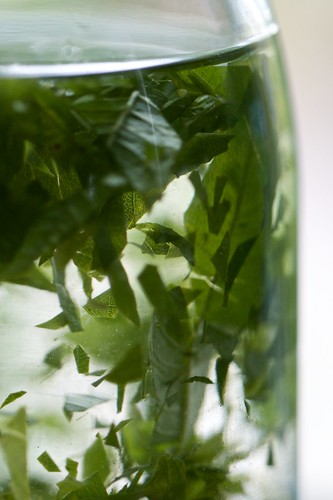Lemon Verbena Infusion
Cold infusion is a less-known method for creating iced teas, and has many advantages over the more common method of chilling tea or hot infusions. To start with, you won't need to spend nearly as much energy to heat and than cool your concoction. Second, and not any less important: some teas truly benefit from not being heated, as it can bring out the best qualities of fresh leaves that would otherwise be destroyed in the process of hot infusion.
Cold infusion requires more time to infuse, but that can be easily done overnight: fill a 1L jar or pitcher with 2-4 sprigs of rinsed, freshly picked lemon verbena (or spearmint, or 4 blades of lemongrass). Cover with spring water or tapwater (filtered if necessary), and let it sit overnight in the refrigerator. In the morning, you'll have a cool, refreshing beverage, which you could fill in your to-go bottle, while covering the herbs again with fresh water for a 2nd cold-infusion.
When cold-infusing fresh lemon verbena leaves, the result is a more grassy, green and delicate infusion. The citral is a little less dominant as well, giving more room for the more floral and green notes. Also, the result is a very clear water, which is most refreshing in the hot summer months. We drank lemon verbene, spearmint or lemongrass infused water all summer and they were thirst-quenching and provided little moments of sanity and a pure luxury while hydrating.
Making a hot infusion is wonderful too - and will bring out the bright yellow colour of lemon verbena. It will, however, require more planning ahead: You'll have to infuse the tea, bring it to room temperature, and than chill it for at least 4 hours, if not overnight (depending on how much power you have in your refrigerator: the one we had in the village was an ice-box size machine with very little cooling power, so everything had to be planned and thought-through well ahead).
I was first introduced to this method by my Canadian-Japanese friend Dean, who would make cold barley "tea" every summer (it's a simple infusion of roasted barley, that is very popular in Japan in the cooler months; you might be also able to find cans of this treat at the Japanese Konbiniya on Robson street - or your own local Japanese/Asian grocery store). Second time I learned about it was from Maria at Shaktea on Main: she recommended this method for making iced tea from their aromatized white and green teas (their Pomegranate & Magnolia was my first time experimenting with this method, and their Elderflower & Cantaloupe is even better this way). It might be a bit tricky with aromatized teas though: the aromas can taste a bit plastic-y and tongue-burning sometimes if they don't udnergo the heating. So you will just have to test and see for each tea if that method makes it better or worse than cooling a hot-infusion. Like the cold infusions of fresh leaves, dried tea infusions may be re-steeped a 2nd and even a 3rd time.
Cold infusion requires more time to infuse, but that can be easily done overnight: fill a 1L jar or pitcher with 2-4 sprigs of rinsed, freshly picked lemon verbena (or spearmint, or 4 blades of lemongrass). Cover with spring water or tapwater (filtered if necessary), and let it sit overnight in the refrigerator. In the morning, you'll have a cool, refreshing beverage, which you could fill in your to-go bottle, while covering the herbs again with fresh water for a 2nd cold-infusion.
When cold-infusing fresh lemon verbena leaves, the result is a more grassy, green and delicate infusion. The citral is a little less dominant as well, giving more room for the more floral and green notes. Also, the result is a very clear water, which is most refreshing in the hot summer months. We drank lemon verbene, spearmint or lemongrass infused water all summer and they were thirst-quenching and provided little moments of sanity and a pure luxury while hydrating.
Making a hot infusion is wonderful too - and will bring out the bright yellow colour of lemon verbena. It will, however, require more planning ahead: You'll have to infuse the tea, bring it to room temperature, and than chill it for at least 4 hours, if not overnight (depending on how much power you have in your refrigerator: the one we had in the village was an ice-box size machine with very little cooling power, so everything had to be planned and thought-through well ahead).
I was first introduced to this method by my Canadian-Japanese friend Dean, who would make cold barley "tea" every summer (it's a simple infusion of roasted barley, that is very popular in Japan in the cooler months; you might be also able to find cans of this treat at the Japanese Konbiniya on Robson street - or your own local Japanese/Asian grocery store). Second time I learned about it was from Maria at Shaktea on Main: she recommended this method for making iced tea from their aromatized white and green teas (their Pomegranate & Magnolia was my first time experimenting with this method, and their Elderflower & Cantaloupe is even better this way). It might be a bit tricky with aromatized teas though: the aromas can taste a bit plastic-y and tongue-burning sometimes if they don't udnergo the heating. So you will just have to test and see for each tea if that method makes it better or worse than cooling a hot-infusion. Like the cold infusions of fresh leaves, dried tea infusions may be re-steeped a 2nd and even a 3rd time.

